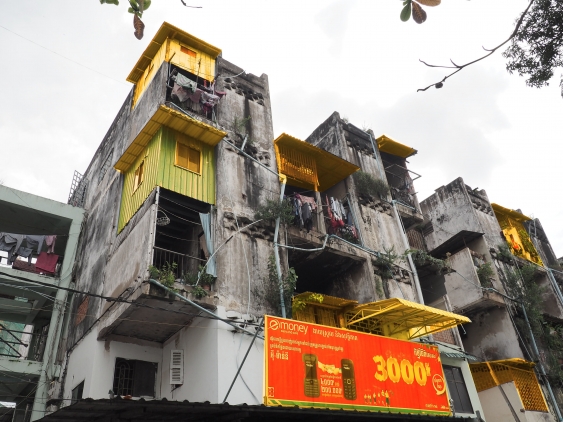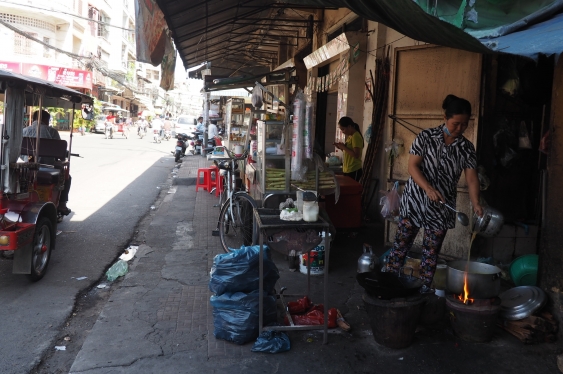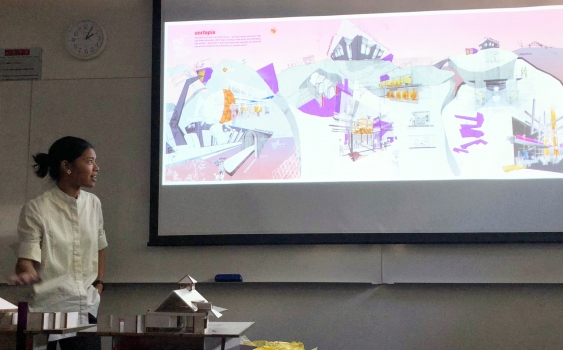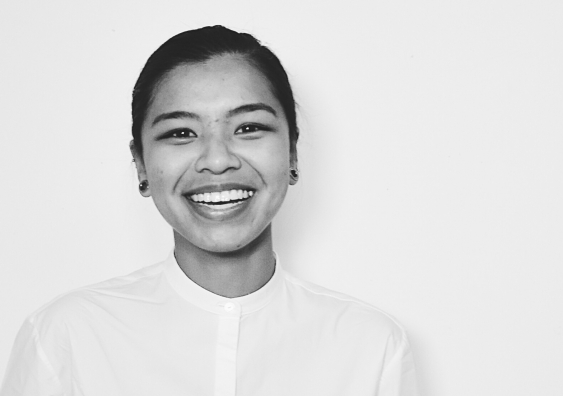It was a 2016 trip to Cambodia that changed Diana Espiritu’s approach to design, and interpretation of the role of interiors and the built environment.
The now fourth-year Bachelor of Interior Architecture (BIA) student at UNSW had visited Phnom Penh as part of the Built Environment (BE) Street Life Studies: Cambodia summer elective course.
BE students studied the development of the urban interior in the city, comparing the street life of Sydney with Phnom Penh.
“The ‘interiors’ of buildings [in Phnom Penh], and domestic activities such as cooking, were often extended onto the pathways,” Ms Espiritu says.
This expansion of private activities into the public realm, and the development of the ‘urban interior’, was particularly apparent at a modernist apartment, the White Building, which then housed community-based non-governmental organisation (NGO) Sa Sa Art Projects.

The development of the ‘urban interior’: the White Building.
“Many buildings throughout Phnom Penh were abandoned during the Cambodian genocide in 1970s,” she says.
“After the defeat of the Khmer Rouge, people were invited to return to any empty apartment block and, after a certain amount of time, they were able to claim it as their own.”
She says the freedom of people to create more user space “reminded me of Elemental’s social housing projects, where they would intentionally build half a house, leaving the other half for the patrons to build.
“It became truly apparent to me the changing role of interiors and designers,” she says.
“It both challenged and revealed ways in which skills from interior architecture could be applied in the urban setting, and how qualities found in interiors were found in the urban setting.”
Ms Espiritu will return to Sa Sa Art Projects, which supports local designers and artists in disadvantaged communities, in January after being awarded the first BIA International Professional Placement Travel Grant.
The travel grant supports a third- or fourth-year BIA student to undertake a Professional Placement in a global workplace context, by funding flights and living expenses and granting course credits.

Activities normally associated with interiors became part of the exterior.
Ms Espiritu will pair up with a Cambodian Royal University of Fine Arts Architecture graduate to support the curation of Sensing the Capital, an arts, architecture and urbanism festival to be held in Phnom Penh later next year.
The students will be mentored by Sa Sa Art Projects’ Artistic Director, Lyno Vuth, and architect Pen Sereypagna.
Ms Vuth says the program provides an opportunity to collaborate within the creative practice.
“We appreciate and value the reciprocal exchange nurtured by the placement,” she says. “The placement is an opportunity not only for students to engage with our practice but to learn from one another.”
Pen Sereypagna, who is also director of Sa Sa Art Projects partner The Vann Molyvann Project, also values the input that will be brought by students from cross-cultural backgrounds.
“We are excited to see how alternate perspectives will form an urbanism festival that aims to engage with the spaces, cultures and people of Phnom Penh.”

Mentoring in a global context: Diana Espiritu.
BE Interior Architecture Lecturer Eva Lloyd was instrumental in establishing the grant, having spent time working as an architect in Cambodia and establishing the Street Life Studies: Cambodia summer elective course.
The graduate from the BIA program says the international partnership is extremely valuable for BIA students who are exposed first-hand to community-based practice work in a developing city context.
“The long-term vision is to expand learning exchange across cultures, by pairing UNSW and Cambodian students in industry placements, both in Phnom Penh and in Sydney.”
This year the travel grant will be funded by Sydney-based BE industry partner and design firm Design Tribe Projects, which is engaged with the BIA through sessional teaching, graduate positions and exhibition sponsorship.
'The long-term vision is to expand learning exchange across cultures, by pairing UNSW and Cambodian students in industry placements, both in Phnom Penh and in Sydney.'
General Manager, Business and Marketing at Design Tribe Projects, Jennifer Snyder, says it is essential to support future generations of designers and open up design theory to global contexts.
“For us, it’s about being a part of the foundations of design learning and mentoring in a global context, and having the opportunity to see talent move from theory to practice is extremely rewarding,” she says.
Discipline Director: Interior Architecture program in UNSW’s BE, Lisa Zamberlan, says the grant is an example of the invaluable opportunities on offer through the BIA program.
“The BIA International Professional Placement Travel Grant will lay the platform for future global partnerships and opportunities for collaboration, and will continue to support design organisations in developing contexts.
“The program aims to foster learning exchange across city contexts and establish an ethos of social agency as an inherent responsibility of all design professionals.”
Ms Espiritu, who has experience in fine arts, including video installations and sculpture, says she is passionate about tackling political and social issues through art and design.
She says she aspires to work within an arts space firm or company, “really incorporating installations, sculpture and public art into my daily practice”.





